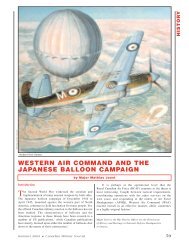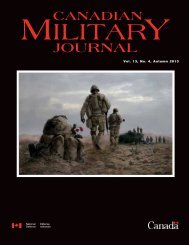MILITARY
JOURNAL CA - Revue militaire canadienne
JOURNAL CA - Revue militaire canadienne
- No tags were found...
Create successful ePaper yourself
Turn your PDF publications into a flip-book with our unique Google optimized e-Paper software.
Another option to help develop physical red teaming skill<br />
sets is to engage in basic research and to undertake a literature<br />
review of what has been written on this training.<br />
The Red Team Journal website provides predominately<br />
analytical red teaming information -<br />
such as the “reciprocal net assessment”<br />
(RNA) approach, however, links and information<br />
exist to some physical resources.<br />
Additionally, US military and intelligence<br />
agency red cells and law enforcement affiliated<br />
entities, such as the National Tactical<br />
Officers Association (NTOA) Project Red,<br />
can be contacted for subject matter expert<br />
support. The guide Red Teams and<br />
Counterterrorism Training, written by<br />
Stephen Sloan and this author, published in 2011 by University<br />
of Oklahoma Press, for example focuses upon how to simulate<br />
active-aggressor forces, including those that may utilize suicide<br />
bombers.<br />
Once a bona fide physical red team is created, or under<br />
some circumstances, a private military red team is contracted,<br />
the priority suicide bomber threat scenarios identified can be<br />
simulated. ‘Simunitions’ should be utilized. This allows for<br />
real weapons to be put into service, however, with barrel conversions<br />
made so that marking rounds are fired. Simulated<br />
explosive devices - from inert suicide vests through VBIEDs,<br />
also have to be obtained or created. The intent is for the<br />
Canadian military forces to undergo as realistic training as<br />
possible, and thus ‘train as they fight.’ Pyrotechnics, smoke,<br />
and other elements can also be brought into play. The creation<br />
of wounding make up applied to victims, and even recreating<br />
the sights and smells of an engagement - for example, the<br />
dumping of animal blood and entrails on a victim requiring<br />
medical attention - should also be considered as options during<br />
the simulated suicide bombing attacks against friendly<br />
forces. Like all forms of<br />
military training, the various<br />
protocols are determined<br />
and logically<br />
thought through, the hardware<br />
and necessary supplies<br />
procured, and the<br />
training venues are either<br />
selected or created.<br />
Training can take place at<br />
a central military facility,<br />
or a mobile training team<br />
approach can be taken. It<br />
is important to note that<br />
simple training should<br />
always take place before<br />
more complex training,<br />
thus the less involved suicide<br />
bomber incident scenarios<br />
should be conducted<br />
first. In addition,<br />
the skill set level exhibited<br />
by the red team vis-àvis<br />
those being trained<br />
“Another option to<br />
help develop physical<br />
red teaming skill<br />
sets is to engage in<br />
basic research and<br />
to undertake a literature<br />
review of what<br />
has been written on<br />
this training.”<br />
should be initially determined. Sometimes below zone training<br />
(the red team initially performs below the capabilities of the<br />
friendly force) may be required as much as in<br />
zone training (red team parity with the<br />
friendly force) and above zone training (red<br />
team superiority over the friendly force), to<br />
allow training objectives to be met. Training<br />
is always dynamic, and scripting should be<br />
followed as little as possible, with basic<br />
training intent, derived from analytical red<br />
team guidance, promoted within an atmosphere<br />
of free play and improvisation.<br />
After the physical red team is created<br />
and equipped, the training scenarios are<br />
developed, the referees and other contingencies<br />
are sorted out, and the means by which the training will<br />
be delivered is determined, the military personnel and units<br />
taking the training can be focused upon. In this instance,<br />
Canadian military forces being deploying overseas where<br />
opposing forces have engaged in suicide bombings would be<br />
given the highest training priority. These forces can either be<br />
trained following current Canadian force protection doctrine,<br />
or the training of this doctrine can become a component of the<br />
simulated force protection mission when the friendly unit is<br />
pitted against the physical red team. More competitive unit<br />
commanders will likely engage in their own force protection<br />
training even if such doctrinal training is provided when the<br />
unit is up against the red team. 21 While this training is not<br />
meant to be a ‘win or lose’ proposition for the friendly forces<br />
-since often failure teaches us far more about personnel and<br />
unit readiness than success - some form of competition is<br />
always a good training motivator for the forces being trained.<br />
After action ‘hot washes’ and ‘lessons learned’ sessions are<br />
also imperative, with candid criticisms of individual and unit<br />
performance in the form of constructive feedback utilized to<br />
promote learning and training takeaways.<br />
International peacekeepers investigate the site of a suicide car bomb attack in Kabul, Afghanistan, 28 January 2004.<br />
Reuters photo RTRBC5D by Ahmad Masood<br />
WARFARE IN THE 21ST CENTURY<br />
Vol. 12, No. 4, Autumn 2012 • Canadian Military Journal 41





